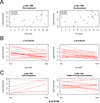PIK3CA/PTEN mutations and Akt activation as markers of sensitivity to allosteric mTOR inhibitors
- PMID: 22422409
- PMCID: PMC3307149
- DOI: 10.1158/1078-0432.CCR-11-2123
PIK3CA/PTEN mutations and Akt activation as markers of sensitivity to allosteric mTOR inhibitors
Abstract
Purpose: We sought to determine whether phosphoinositide 3-kinase (PI3K) pathway mutation or activation state and rapamycin-induced feedback loop activation of Akt is associated with rapamycin sensitivity or resistance.
Experimental design: Cancer cell lines were tested for rapamycin sensitivity, Akt phosphorylation, and mTOR target inhibition. Mice injected with breast or neuroendocrine cancer cells and patients with neuroendocrine tumor (NET) were treated with rapalogs and Akt phosphorylation was assessed.
Results: Thirty-one cell lines were rapamycin sensitive (RS) and 12 were relatively rapamycin resistant (RR; IC(50) > 100 nmol/L). Cells with PIK3CA and/or PTEN mutations were more likely to be RS (P = 0.0123). Akt phosphorylation (S473 and T308) was significantly higher in RS cells (P < 0.0001). Rapamycin led to a significantly greater pathway inhibition and greater increase in p-Akt T308 (P < 0.0001) and p-Akt S473 (P = 0.0009) in RS cells. Rapamycin and everolimus significantly increased Akt phosphorylation but inhibited growth in an in vivo NET model (BON). In patients with NETs treated with everolimus and octreotide, progression-free survival correlated with p-Akt T308 in pretreatment (R = 0.4762, P = 0.0533) and on-treatment tumor biopsies (R = 0.6041, P = 0.0102). Patients who had a documented partial response were more likely to have an increase in p-Akt T308 with treatment compared with nonresponders (P = 0.0146).
Conclusion: PIK3CA/PTEN genomic aberrations and high p-Akt levels are associated with rapamycin sensitivity in vitro. Rapamycin-mediated Akt activation is greater in RS cells, with a similar observation in patients with clinical responses on exploratory biomarker analysis; thus feedback loop activation of Akt is not a marker of resistance but rather may function as an indicator of rapamycin activity.
Figures





References
-
- Noh WC, Mondesire WH, Peng J, Jian W, Zhang H, Dong J, et al. Determinants of rapamycin sensitivity in breast cancer cells. Clin Cancer Res. 2004;10:1013–1023. - PubMed
-
- Wan X, Harkavy B, Shen N, Grohar P, Helman LJ. Rapamycin induces feedback activation of Akt signaling through an IGF-1R-dependent mechanism. Oncogene. 2007;26:1932–1940. - PubMed
-
- Sun SY, Rosenberg LM, Wang X, Zhou Z, Yue P, Fu H, et al. Activation of Akt and eIF4E survival pathways by rapamycin-mediated mammalian target of rapamycin inhibition. Cancer Res. 2005;65:7052–7058. - PubMed
Publication types
MeSH terms
Substances
Grants and funding
LinkOut - more resources
Full Text Sources
Other Literature Sources
Medical
Molecular Biology Databases
Research Materials
Miscellaneous

